
Dreadlocks, also known as dreads or locs, are a hairstyle made of rope-like strands of hair. This is done by not combing the hair and allowing the hair to mat naturally or by twisting it manually. Over time the hair will form tight braids or ringlets.

A buzz cut, or wiffle cut, is a variety of short hairstyles, especially where the length of hair is the same on all parts of the head. Rising to prominence initially with the advent of manual hair clippers, buzz cuts became increasingly popular in places where strict grooming conventions applied. In several nations, buzz cuts are often given to new recruits in the armed forces. However, buzz cuts are also used for stylistic reasons.
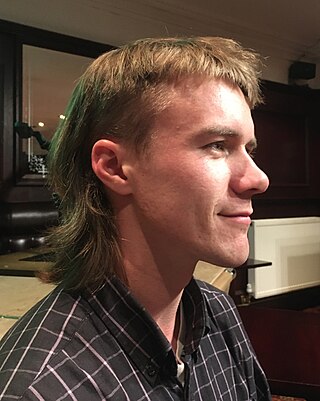
The mullet is a hairstyle in which the hair is cut shorter at the front, top and sides, but is longer at the back.

A bob cut, also known as a bob, is a short to medium length haircut, in which the hair is typically cut straight around the head at approximately jaw level, and no longer than shoulder-length, often with a fringe at the front. The standard bob cut exposes the back of the neck and keeps all of the hair well above the shoulders.

Hip-hop fashion refers to various styles of dress that originated from Urban Black America and inner-city youth in cities like New York City, Atlanta, and Los Angeles. Being a major part of hip hop culture, it further developed in other cities across the United States, with each contributing different elements to the overall style that is now recognized worldwide.

The afro is a hair style created by combing out natural growth of afro-textured hair, or specifically styled with chemical curling products by individuals with naturally curly or straight hair. The hairstyle can be created by combing the hair away from the scalp, dispersing a distinctive curl pattern, and forming the hair into a rounded shape, much like a cloud or puff ball.

Hi-top fade is a haircut where hair on the sides is cut off or kept very short while hair on the top of the head is grown long.

Fashion in the 1990s was defined by a return to minimalist fashion, in contrast to the more elaborate and flashy trends of the 1980s. One notable shift was the mainstream adoption of tattoos, body piercings aside from ear piercing and, to a much lesser extent, other forms of body modification such as branding.
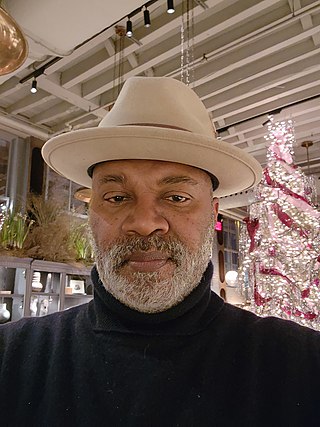
Nelson George is an American author, columnist, music and culture critic, journalist, and filmmaker. He has been nominated twice for the National Book Critics Circle Award.

A shape-up, also called a line-up or an edge-up, is a hairstyle that involves cutting along the natural hairline to straighten it. Edge-ups are typically found among men and short-haired women. The haircut grew in popularity during the 1980s, typically among those who have Afro-textured hair, and became the precursor to other stylish haircuts, such as the high-top fade, low fade, and designs such as crescent moon parts, side parts, and waves in hair.

Long hair is a hairstyle where the head hair is allowed to grow to a considerable length. Exactly what constitutes long hair can change from culture to culture, or even within cultures. For example, a woman with chin-length hair in some cultures may be said to have short hair, while a man with the same length of hair in some of the same cultures would be said to have long hair.
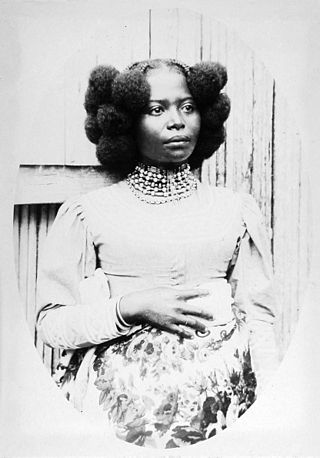
Kinky hair, also known as afro-textured hair, is a human hair texture prevalent in the indigenous populations of many regions with hot climates, mainly sub-Saharan Africa, Melanesia, and Australia. Each strand of this hair type grows in a tiny, angle-like helix shape. The overall effect is such that, contrasted with straight hair, wavy hair, or curly hair, kinky hair appears denser.
Hip-hop or hip hop, also known as rap, and formerly known as disco rap, is a genre of popular music that originated in the early 1970s by African Americans and Caribbean immigrants in the Bronx, a borough of New York City. Hip-hop music originated as an anti-drug and anti-violence genre consisting of stylized rhythmic music that often accompanies rapping, a rhythmic delivery of poetic speech. According to the professor Asante of African American studies at Temple University, "hip hop is something that blacks can unequivocally claim as their own". The music developed as part of the broader hip hop culture, a subculture defined by four key stylistic elements: MCing/rapping, DJing/scratching with turntables, breakdancing, and graffiti art. While often used to refer solely to rapping and rap music, "hip hop" more properly denotes the practice of the entire subculture. The term hip hop music is sometimes used synonymously with the term rap music, though rapping is not a required component of hip hop music; the genre may also incorporate other elements of the culture, including DJing, turntablism, scratching, beatboxing, and instrumental tracks.

The 2010s were defined by hipster fashion, athleisure, a revival of austerity-era period pieces and alternative fashions, swag-inspired outfits, 1980s-style neon streetwear, and unisex 1990s-style elements influenced by grunge and skater fashions. The later years of the decade witnessed the growing importance in the western world of social media influencers paid to promote fast fashion brands on Pinterest and Instagram.
Urban pop culture is the pop culture of cities and towns. It is both driven by and drives the popular culture of mainstream media. Urban pop culture tends to be more cosmopolitan and liberal than mainstream culture, but is not without its own complex mores, reflecting, for example, the parent societies' ambivalence to sexuality.
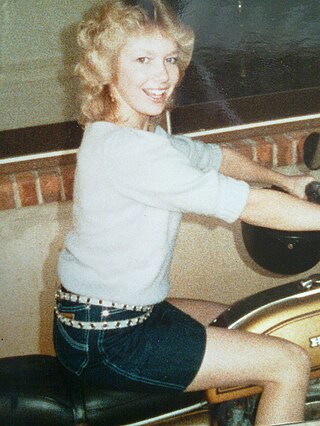
Hairstyles in the 1980s included the mullet, tall mohawk hairstyles, jheri curls, flattops, and hi-top fades, which became popular styles. Amongst women, large hair-dos, puffed-up styles, permanent waves, and softer cuts typified the decade. Big hair that was "often permed to achieve the desired volume" is especially associated with women of the mid 1980s as well as male rockstars of that era, especially of the glam metal genre. Television shows such as Dynasty helped popularize the high volume bouffant and glamorous image associated with it.
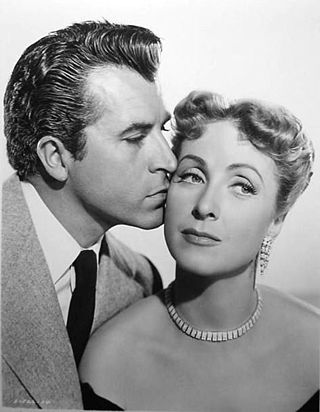
In the Western world, the 1950s were a decade known for experimentation with new styles and culture. Following World War II and the austerity years of the post-war period, the 1950s were a time of comparative prosperity, which influenced fashion and the concept of glamour. Hairstylists invented new hairstyles for wealthy patrons. Influential hairstylists of the period include Sydney Guilaroff, Alexandre of Paris and Raymond Bessone, who took French hair fashion to Hollywood, New York and London, popularising the pickle cut, the pixie cut and bouffant hairstyles.
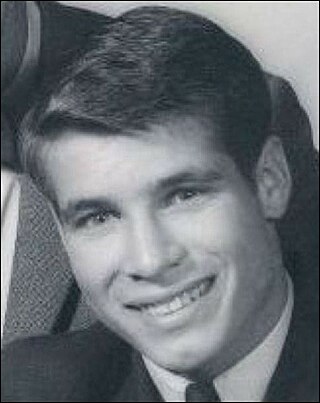
A regular haircut, in Western fashion, is a men's and boys' hairstyle that has hair long enough to comb on top, a defined or deconstructed side part, and a short, semi-short, medium, long, or extra long back and sides. The style is also known by other names including taper cut, regular taper cut, side-part and standard haircut; as well as short back and sides, business-man cut and professional cut, subject to varying national, regional, and local interpretations of the specific taper for the back and sides.
Drill is a subgenre of hip hop music that originated in Chicago in the early 2010s. It is sonically similar to the trap music subgenre and lyrically similar to the gangsta rap subgenre. Early drill artists are noted for their explicit, confrontational style of lyricism and association with crime in Chicago, especially the Black Disciples and Gangster Disciples. The genre progressed into the American mainstream in 2012 following the success of pioneering rappers like Chief Keef, Lil Reese, Lil Durk, Fredo Santana, G Herbo, Lil Bibby and King Louie, who had many local fans and a significant internet presence alongside producer Young Chop. Other rappers, such as L’A Capone, RondoNumbaNine, SD, FBG Duck, Lil Jojo and producer Leekeleek also contributed to the early drill scene. As the audience grew, media attention and the signing of drill musicians to major labels followed. After the initial momentum of the subgenre subsided, Chicago drill saw a resurgence in the late 2010s and early 2020s with trailblazing artists such as King Von, Polo G, Calboy and a renewed Lil Durk.
Leikeli47 is an American rapper signed to RCA Records. In 2018, she released her second full-length album, Acrylic. She is known for concealing her face with a bandana or balaclava at all performances and professional appearances.
















